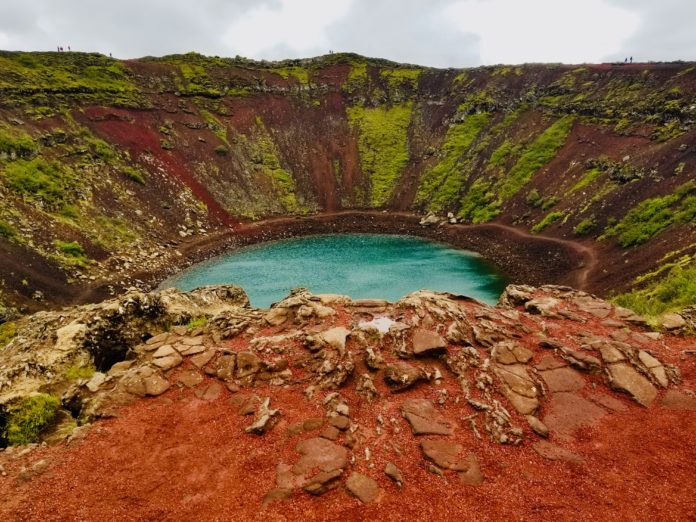Most volcano eruptions can be predicted before they happen by monitoring the underground structures around them. Leading up to an eruption, small earthquakes and underground tremors will become more frequent in the area as pools of molten rock called magma start to push up against the surface. But sometimes volcanoes erupt without warning, suggesting that some underground activity isn’t being detected.
When it comes to these unexpected eruptions, the shallowest pools of magma pose the deepest problems, according to a new study from McGill University. The study was led by Shane Rooyakkers, a Rutherford Postdoctoral Fellow at GNS Science who recently completed a PhD in volcanology at McGill University, and published in Geology.
How can we predict volcanic eruptions?
Although scientists can’t predict exactly when a volcano will erupt, or how severe the eruption will be, they can get a pretty good estimate by monitoring the volcano over time.
In many cases, this monitoring takes the form of seismic imaging, where scientists study sound waves generated during earthquakes and measure how long it takes these sound waves to travel through the Earth’s crust. The speed of the sound wave will change as it passes through different materials, and this information can tell scientists that materials like magma are present below the Earth’s surface.
Knowing where these pools of magma are located can help scientists predict when and where volcanoes will erupt. By monitoring these pools of magma over time, scientists will notice when they start pushing up against the ground and causing earthquakes or tremors that indicate upcoming volcanic activity.
For many years, volcanologists believed that these techniques were sensitive enough to detect the majority of magma pools that could lead to volcanic eruptions. Yet in 2009, scientists from the Iceland Deep Drilling Project accidentally drilled directly into a magma pool in Krafla, Iceland that was two kilometres shallower than previous detections in the area — and which had not been picked up by seismic imaging techniques.
This discovery was particularly unexpected because Krafla hosts one of Iceland’s most explosive volcanoes, and has been closely monitored through seismic imaging for many years.
Scientists from the Iceland Deep Drilling Project guessed that the magma had been deposited in the area much more recently — meaning that it was not linked to centuries-old eruptions of the Krafla volcano — but until Rooyakkers and his colleagues decided to investigate the magma in more detail, its exact origin remained unknown.
Linking the magma to ancient eruptions
Rooyakkers and his team compared samples of the magma that had been drilled into in 2009 with rocks from an eruption at the Krafla volcano in 1724. If the magma had been deposited in the area more recently, the compositions of the two samples likely wouldn’t match.
To Rooyakkers’ surprise, however, the magma pool appeared to be much older than scientists had assumed.
“When we looked at the compositions from 1724, we found an almost perfect match for what was sampled during the drilling,” Rooyakkers said in a news release.
“That suggests that actually, this magma body has been there since 1724 and has previously been involved in an eruption at Krafla. So that raises the question of, ‘Why did geophysics not pick it up?'”
When it comes to predicting volcanic eruptions, size matters
After studying the magma pool in more detail, Rooyakkers and his team realized that the answer lies in its size.
Because the pool is so shallow, traditional seismic imaging techniques weren’t able to detect the small change in speed as sound waves passed through it. This meant that the pool remained undetected until scientists accidentally drilled into it in 2009.
Rooyakkers’ findings challenge traditional views of volcanic activity. While volcanologists had previously assumed that volcanoes are fed by much deeper magma chambers — which can be readily detected with seismic imaging techniques — this discovery suggests that shallower magma pools may also have a role to play.
Their findings also suggest that volcanologists will need to keep shallow magma pools in mind when considering the risks posed by volcanoes in the future.
“So the concern in this case would be that you have a shallow […] magma that you don’t know about, so it hasn’t been considered in hazards planning,” Rooyakkers explained.
The authors recommend that scientists place more seismic detectors at volcanic sites in order to improve the resolution of seismic monitoring data. While this would be costly, and would still run the risk of missing particularly shallow pools, it could help protect communities living near active volcanoes.
“Our discovery […] serves as a stark warning for possible future eruption scenarios,” the authors said in their paper. “[C]overt […] magma may exist at many other volcanoes and should be considered in hazard and risk assessments.”








































